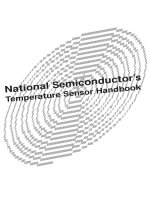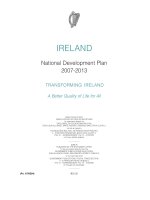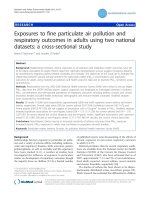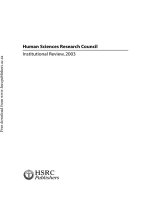national research council national convocation
Bạn đang xem bản rút gọn của tài liệu. Xem và tải ngay bản đầy đủ của tài liệu tại đây (207.47 KB, 20 trang )
Mathematics
Education
in the
Middle Grades
Teaching to Meet the Needs of
Middle Grades Learners and to
Maintain High Expectations
Proceedings of a National Convocation and Action Conferences
Center for Science, Mathematics, and Engineering Education
National Research Council
NATIONAL ACADEMY PRESS
Washington, DC
NOTICE: The project that is the subject of this report was approved by the Governing Board of the
National Research Council, whose members are drawn from the councils of the National Academy of
Sciences, the National Academy of Engineering, and the Institute of Medicine. The members of the
committee responsible for the convocation and report were chosen for their special competences and with
regard for appropriate balance.
The Center for Science, Mathematics, and Engineering Education (CSMEE) was established in 1995 to
provide coordination of all the National Research Council’s education activities and reform efforts for
students at all levels, specifically those in kindergarten through twelfth grade, undergraduate institutions,
school-to-work programs, and continuing education. The Center reports directly to the Governing Board
of the National Research Council.
The Convocation and Action Conferences about which these proceedings report were funded by a grant
from the U.S. Department of Education with additional funding from the American Educational Research
Association. Any opinions, findings, or recommendations expressed in this report are those of members
of the steering committee or participants in the Convocation and Action Conferences and do not necessarily reflect the views of the U.S. Department of Education.
Library of Congress Cataloging-in-Publication Data
Mathematics education in the middle grades : teaching to meet the needs
of middle grades learners and to maintain high expectations :
proceedings of a national convocation and action conferences / Center
for Science, Mathematics, and Engineering Education, National Research
Council.
p. cm.
Includes bibliographical references.
ISBN 0-309-06797-9 (pbk.)
1. Mathematics—Study and teaching (Middle school)—United
States—Congresses. I. Center for Science, Mathematics, and Engineering
Education.
QA13 .M156 1999
510'.72—dc21
99-050765
Additional copies of this report are available from National Academy Press, 2101 Constitution Avenue,
N.W., Lock Box 285, Washington, DC 20055. Call (800) 624-6242 or (202) 334-3313 (in the
Washington metropolitan area).
This report is also available online at .
Printed in the United States of America
Copyright 2000 by the National Academy of Sciences. All rights reserved.
National Academy of Sciences
National Academy of Engineering
Institute of Medicine
National Research Council
The National Academy of Sciences is a private, nonprofit, self-perpetuating society of distinguished
scholars engaged in scientific and engineering research, dedicated to the furtherance of science and
technology and to their use for the general welfare. Upon the authority of the charter granted to it by the
Congress in 1863, the Academy has a mandate that requires it to advise the federal government on
scientific and technical matters. Dr. Bruce M. Alberts is president of the National Academy of Sciences.
The National Academy of Engineering was established in 1964, under the charter of the National
Academy of Sciences, as a parallel organization of outstanding engineers. It is autonomous in its
administration and in the selection of its members, sharing with the National Academy of Sciences the
responsibility for advising the federal government. The National Academy of Engineering also sponsors
engineering programs aimed at meeting national needs, encourages education and research, and recognizes the superior achievements of engineers. Dr. William A. Wulf is president of the National Academy
of Engineering.
The Institute of Medicine was established in 1970 by the National Academy of Sciences to secure the
services of eminent members of appropriate professions in the examination of policy matters pertaining to
the health of the public. The Institute acts under the responsibility given to the National Academy of
Sciences by its congressional charter to be an adviser to the federal government and, upon its own
initiative, to identify issues of medical care, research, and education. Dr. Kenneth I. Shine is president of
the Institute of Medicine.
The National Research Council was organized by the National Academy of Sciences in 1916 to associate
the broad community of science and technology with the Academy’s purposes of furthering knowledge and
advising the federal government. Functioning in accordance with general policies determined by the
Academy, the Council has become the principal operating agency of both the National Academy of
Sciences and the National Academy of Engineering in providing services to the government, the public,
and the scientific and engineering communities. The Council is administered jointly by both Academies and
the Institute of Medicine. Dr. Bruce M. Alberts and Dr. William A. Wulf are chairman and vice chairman,
respectively, of the National Research Council.
NATIONAL CONVOCATION ON MATHEMATICS EDUCATION
IN THE MIDDLE GRADES
Program Steering Committee
Edward Silver, Chair, Professor and Senior Scientist, Learning Research Development Center, University of
Pittsburgh, Pittsburgh, PA
Representatives, Mathematical Sciences Education Board
Hyman Bass (NAS)*, Professor of Mathematics, Columbia University, New York, NY
Benjamin Blackhawk, Mathematics Teacher, St. Paul Academy and Summit School, Crystal, MN
Susan S. Wood, Professor of Mathematics, J. Sargeant Reynolds Community College, Richmond, VA
Representatives, American Educational Research Association
Robert Linn, Distinguished Professor of Education, University of Colorado, Boulder, CO
Sandra Wilcox, Associate Professor of Teacher Education, Michigan State University, East Lansing, MI
Representatives, National Council of Teachers of Mathematics
Catherine Brown, Associate Professor of Curriculum and Instruction, Indiana University, Bloomington, IN
Karen Longhart, Mathematics Teacher, Flathead High School, Kalispell, MT
Representatives, National Middle School Association
Sam Chattin, Science Teacher, William H. English Middle School, Scottsberg, IN
Katherine Rasch, Dean and Professor of Education, Maryville University, Chesterfield, MO
Member-At-Large
Shirley Sagawa, Executive Director, Learning First Alliance, Washington, DC
National Research Council Staff
Gail Burrill, Project Director
Rodger Bybee, Executive Director, CSMEE
Kristance Coates, Project Assistant
Joan Ferrini-Mundy, Associate Executive Director, CSMEE
Bradford Findell, Program Officer
DeVonne Robertson, Program Assistant
Kirsten Sampson Snyder, Administrative Officer
Doug Sprunger, Senior Project Assistant
Tina Winters, Senior Project Assistant
*NAS: Member of the National Academy of Sciences
v
Acknowledgments
The National Academy of Sciences
gratefully acknowledges the U.S. Department of Education for its generous
financial support of the Convocation and
Action Conferences and these proceedings, the American Educational Research Association for its additional
financial support and co-sponsorship of
the Convocation and Action Conferences, and the National Middle School
Association and National Council of
Teachers of Mathematics for their cosponsorship of the Convocation and
Action Conferences. Any opinions,
findings, and conclusions or recommendations expressed in this material are
those of the authors and do not necessarily reflect those of the funders.
We would like to acknowledge the
staff at the National Research Council’s
(NRC) Center for Science, Mathematics, and Engineering Education
(CSMEE) for their efforts in putting the
Convocation and Action Conferences
together. In particular, Tina Winters
was instrumental in overseeing logistical arrangements for the meetings, and
in organizing these proceedings for
review and publication. She was supported in her efforts by Kirsten
Sampson Snyder and Doug Sprunger.
Others who provided on-site support
were Kristance Coates and DeVonne
Robertson.
We are grateful to the members of the
Program Steering Committee for their
oversight in planning of the programs
for the Convocation and Action Conferences. We would also like to thank
Anthony Jackson for his contributions to
the program planning and his assistance
with resources for the Convocation.
Additional thanks go to Deborah
Loewenberg Ball, Hyman Bass, and
Sandra Wilcox for their instrumental
roles in the organization of the Action
Conference on the Professional Development of Teachers of Mathematics in
the Middle Grades, the Action Conference on the Nature and Teaching of
Algebra in the Middle Grades, and the
Action Conference on Research in the
Teaching and Learning of Mathematics
in the Middle Grades, respectively. We
also wish to acknowledge the speakers
and discussion group facilitators for
their contributions and leadership that
gave substance to the discussion.
It should be noted that these proceedings have been reviewed by individuals
vii
chosen for their diverse perspectives
and technical expertise, in accordance
with procedures approved by the NRC’s
Report Review Committee. The purpose of this independent review is to
provide candid and critical comments
that will assist the NRC in making the
published report as sound as possible
and to ensure that the report meets
institutional standards for objectivity,
evidence, and responsiveness to the
study charge. The content of the review
comments and draft manuscript remains
confidential to protect the integrity of
the deliberative process.
We wish to thank the following
individuals for their participation in the
review of this report:
viii
Gilberto Cuevas, University of Miami
Nina Koltnow, Sidwell Friends School
Sidney L. Rachlin, East Carolina
University
Marlyn Spivak, Jack London Middle
School
While these individuals have provided
many constructive comments and
suggestions, responsibility for the final
content of this report rests solely with
the authoring committee and the NRC.
GAIL BURRILL
Project Director, Mathematics Education
in the Middle Grades
Preface
Learning mathematics in the middle
grades is a critical component in the
education of our nation’s youth. The
mathematics foundation laid during
these years provides students with the
skills and knowledge to study higher
level mathematics during high school,
provides the necessary mathematical
base for success in other disciplines such
as science, and lays the groundwork for
mathematically literate citizens. A
variety of evidence suggests that the
mathematics education landscape is
shifting and evolving rapidly. Below
average mathematics achievement
scores for grade eight U. S. students as
reported in the Third International
Mathematics and Science Study (TIMSS)
(U.S. Department of Education, 1996)
stimulated national concern leading to a
variety of activities and proposals focusing attention on mathematics education.
Data from the National Assessment of
Educational Progress (NAEP) (National
Center for Education Statistics, 1997)
indicates that while the nation has
demonstrated progress over time, the
achievement levels for all students are
not yet satisfactory. Research about
mathematics education has begun to
have implications for classroom practice.
States are setting high standards for
student achievement and aligning their
assessments with those standards. The
National Council of Teachers of Mathematics (NCTM) is preparing Principles
and Standards for School Mathematics, an
updated version of its previous standards
documents: Curriculum and Evaluation
Standards for School Mathematics,
(NCTM, 1989); Professional Standards for
Teaching Mathematics, (NCTM, 1991);
and Assessment Standards for School
Mathematics, (NCTM, 1995).
As educators focus on improving
mathematics education, they face a
variety of issues. The problems of
middle grades mathematics education
are substantial and differ from those at
the elementary and secondary levels.
There are issues about:
• Content. What mathematics content
is appropriate? How can the characterization of the U.S. mathematics
curriculum as a “mile wide, inch
deep” be addressed? How can the
mathematics curriculum be strengthened yet respect the development
issues so central to middle grades
students? What is the nature of
algebra at the middle grades and how
does it influence the curriculum?
• How middle grades students
learn mathematics. What is the
balance between conceptual under-
ix
standing and practice? What is the
role of manipulatives in helping
students learn? How do students build
understanding of a concept over time?
• Teaching mathematics at the
middle grades. To what extent
do teacher background and preparation specifically for the teaching of
mathematics have an impact on what
students learn? How can the issue of
specialist versus generalist be resolved? What teaching practices are
most effective with middle grades
students? How can teachers help
students grow as individuals yet
ensure that they learn mathematics?
• School organization and its
relation to the teaching and
learning of mathematics. How
does the study of mathematics fit into
the “house” concept? What are the
characteristics of school structures
that promote mathematics learning?
Are cross-disciplinary teams compatible with vertical articulation? What
are the effects of school organization,
scheduling, and philosophy on the
mathematics program?
• Research. How can the knowledge
gained from research be used to
improve teaching and learning of
mathematics in the middle grades?
How can an agenda for continued
research that builds on the state of
the field as well as moves the thinking
forward be framed? What help do
teachers need to translate research
into practice? How might teachers
become researchers themselves as
x
they reflect on their practice and on
ways to improve?
These issues contribute to the
challenge of improving mathematics
education at the middle grades.
Change in schools and in teaching
practice has been slow to occur.
Evidence is mixed about the effects
and directions of ef forts to improve
mathematics education. Engaging
the community at large in conversation about their goals and perspectives is a critical step to help the
nation raise the bar and maximize
opportunities for all middle grades
children in its schools. The dialogue
and shared visions that occurred at
the Convocation—plenar y sessions,
panels, and small group discussions—can set the stage for making a
dif ference.
REFERENCES
National Center for Education Statistics. (1996).
Pursuing excellence: A study of U.S. eighth grade
mathematics and science teaching, learning,
curriculum, and achievement in international
context. Washington, DC: Author.
National Council of Teachers of Mathematics.
(1989). Curriculum and evaluation standards
for school mathematics. Reston, VA: Author.
National Council of Teachers of Mathematics.
(1991). Professional standards for teaching
mathematics. Reston, VA: Author.
National Council of Teachers of Mathematics.
(1995). Assessment standards for school
mathematics. Reston, VA: Author.
Reese, C.M., Miller, K.E., Mazzeo, J., & Dossey,
J.A. (1997). NAEP 1996 mathematics report
card for the nation and the states. Washington,
DC: National Center for Education Statistics.
Contents
ACKNOWLEDGMENTS
vii
PREFACE
ix
LETTER FROM THE PROGRAM STEERING COMMITTEE
1
EXECUTIVE SUMMARY
5
PARTICIPANT OBSERVATIONS
14
CONVOCATION PAPERS AND DISCUSSION SUMMARIES
19
Teaching and Learning Mathematics at the Middle Grades:
Setting the Stage
Mathematics in the Middle: Building a Firm Foundation
of Understanding for the Future — Glenda Lappan
The Middle School Learner: Contexts, Concepts, and
the Teaching Connection — Thomas Dickinson
Content and Learning Issues in the Middle Grades
Reflections on Middle School Mathematics — Nancy Doda
Mathematics Content and Learning Issues in the
Middle Grades — Kathleen Hart
Summary of Small Group Discussion on Content and
Learning Issues in Middle Grades Mathematics
Teaching Issues in the Middle Grades
Using Video of Classroom Practice as a Tool to Study and
Improve Teaching — Nanette M. Seago
Panel Reactions to the “Cindy Video”
Teaching and Learning Mathematics in the Middle Grades:
Student Perspectives — Linda Foreman
21
23
32
39
41
50
58
61
63
76
79
xi
Panel Response to Foreman Student Video
Summary of Small Group Discussion on Teaching Issues in
the Middle Grades
Organizational Issues in the Middle Grades
The Organization and Structure of Schools at the Middle Grades:
A Principal’s Perspective — Adapted from the Transcript of
Remarks by Stephen O. Gibson
The Organization and Structure of Schools at the Middle Grades:
The Role of Development, Subject Matter, and Teacher
Professional Development — Mary Kay Stein
Improving Achievement in the Middle Grades in Mathematics
and Related Areas: Lessons from the Project on High
Performance Learning Communities — Robert D. Felner et al.
Panel Discussion on the Organization of Schools at the Middle Grades
90
92
95
97
101
111
125
Closing Remarks
Reflections on the Convocation
Adapted from the transcript of remarks by Edward Silver
129
ACTION CONFERENCES
141
Action Conference on the Nature and Teaching of Algebra in
the Middle Grades
Action Conference on Research in the Teaching and Learning of
Mathematics in the Middle Grades
Action Conference on the Professional Development of
Teachers of Mathematics in the Middle Grades
131
143
160
168
APPENDICES
1. Convocation and Action Conference Agendas
2. Biographical Information on Convocation and Action
Conference Speakers
3. Convocation and Action Conference Participant Lists
4. Marcy’s Dots
5. Discussion Session Worksheets
6. Background Paper for the Convocation: What Is 8th Grade
Mathematics: A Look from NAEP — John Dossey
7. Resources
xii
179
189
215
239
245
247
253
Mathematics
Education
in the
Middle Grades
Letter from the Program
Steering Committee
As representatives of the co-sponsoring organizations and the education
community, we would like the Convocation to be viewed as the first step in a
continuing dialogue. In particular, we
hope that the essence of the Convocation
will be replicated by states and regional
groups affiliated with the parent organizations. To support such state and
regional groups, the thinking and structure we used to design the program is
described below. The intent was to
contrast the perspectives brought by
each of the sponsoring organizations and
their constituencies, to raise issues about
these perspectives, to promote interaction, and, through small discussion
groups, to engage participants in reflecting on their own role in middle grades
mathematics education. To reinforce the
points illustrated by the plenary speakers, the small group discussions involved
participants in an analysis of a “site of
practice,” grounding the conversation in
what teachers and students actually do in
classrooms. Discussion group leaders
were given instruction and direction for
working with their groups following the
opening plenary session and were
provided with complete packets of
materials for use with their groups over
the two days. Before the conference,
participants were given materials as
background reading and to help them
begin to focus on the issues framing the
Convocation. (See page 5.)
The Convocation began with speakers
who presented teaching middle school
mathematics from two points of view:
teaching mathematics with a focus on the
subject matter content or teaching mathematics with a focus on the whole child
and whole curriculum. The purpose of
this session was to set the stage for
thinking about middle grades mathematics classrooms from these two perspectives and to stimulate thinking throughout
the rest of the Convocation about teaching
and learning mathematics through these
different lenses. Within this framework,
the Convocation was organized around
three central themes with a set of organizing questions for each theme:
• content and learning in middle grades
mathematics;
• middle grades mathematics teaching; and
• organization of middle grades instructional programs and their impact on
mathematics teaching and learning.
1
Each of these themes was introduced
with a plenary session, where individual
speakers or a panel described some part
of the landscape. Discussion groups that
addressed the issues in terms of an
activity selected from the actual practice
of teaching followed the first two plenary
sessions. The discussion groups were
composed of ten or fewer participants
that by design represented a mix of three
groups: classroom teachers, teacher
educators and university representatives,
and those in some way responsible for a
system including administrators, representatives from state and local systemic
initiatives, and curriculum supervisors.
In addition, time was provided for district
teams to meet and address their concerns in light of the Convocation conversation. The teams were configured
differently depending on the needs of the
system they represented, with some
team members from a given school
district while other teams were a blend of
teachers and university mathematics
educators with common goals for a
district.
THE CONVOCATION THEMES
Middle Grades Content and
Learning Issues
The plenary session on content and
learning mathematics in the middle
grades focused on the questions:
2
• What developmental considerations
are important in thinking about
middle school students as learners?
as learners of mathematics? Are
these compatible?
• What do we know about middle
school students’ capacity for learning?
for learning mathematics?
• What are important ideas in mathematics for the middle grades and
how are these related to developmental learning considerations?
There were two speakers, one
presenting a middle grades perspective
about learning, including comments
about thematic units and integrated
curricula, and the second addressing
how students learn certain mathematics concepts in the middle grades from
the perspective of mathematics education research. The discussion group
participants worked through Marcy’s
Dots (see page 58), an algebraic reasoning problem from the 1992 National
Assessment of Educational Progress,
then reflected on student strategies
(Appendix 4, page 240) in light of their
own thinking. This was followed by a
discussion about learning mathematics
based on the middle grades algebra
section from the 1998 National Council
of Teachers of Mathematics Principles
and Standards for School Mathematics:
Discussion Draft using the lens of the
child and the lens of content.
M AT H E M AT I C S E D U C AT I O N I N T H E M I D D L E G R A D E S
Middle Grades Teaching Issues
Two videos about the practice of
teaching were the focus of the plenary
session on teaching. In the first video,
students discussed the nature of
mathematics teaching and how they
had learned mathematics through the
actions and beliefs of their teacher.
The second featured an eighth grade
class during a lesson on algebraic
thinking. The audience was asked to
view the videos in light of the following
questions:
• What are the important characteristics of effective teaching in the
middle grades? of effective teaching
of mathematics in the middle
grades?
• How can instruction in middle grades
classrooms be organized to maximize
learning? How can we tell when
learning is happening?
• What tools and strategies will make a
difference in how middle grades
students learn mathematics?
Following each video a panel
composed of a middle grades teacher,
a mathematician, and a mathematics
educator reacted to the three questions. The comments and reactions
of the panel within the framework of
the focus questions were used to
shape the participant discussion
sessions.
PROGRAM STEERING COMMITTEE
Middle Grades School
Organizational Issues
How middle grades are organized and
the impact of that organization on the
teaching and learning of mathematics
was the theme of a panel discussion in
this plenary session. Panelists were
asked to consider:
• What are the important characteristics of school organization and mathematics programs that support
teaching and learning meaningful
mathematics in the middle grades?
• How can the schedules of teachers and
students be organized to implement
what we know about effective teaching
and learning in the middle grades?
• What are the issues surrounding
specialists vs. generalists? What kind
of teaching assignments maximize
program effectiveness in mathematics?
Following the panel presentation, the
panelists were asked to address specific
questions raised during the Convocation
with questions and reaction from the
audience. The chair of the Steering
Committee gave a closing summary of
the issues and challenges raised during
the Convocation.
It is our hope that this overview will
be useful for the reader to both understand the nature of the Convocation and
to think about the design as one that
might energize other communities to
structure a similar venture.
3
Executive Summary
As an initial step to address national,
state, and local issues of teaching and
learning mathematics in the middle
grades, the Mathematical Sciences
Education Board (MSEB) of the National Research Council’s Center for
Science, Mathematics, and Engineering
Education (CSMEE), the American
Educational Research Association
(AERA), the National Council of Teachers of Mathematics (NCTM), and the
National Middle School Association
(NMSA) co-sponsored a National
Convocation on Middle Grades Mathematics. The Convocation was held at
the National Academy of Sciences in
Washington DC, on 25-27 September
1998 with support from the U.S. Department of Education and the AERA. The
goals of the Convocation were to
• challenge the nation’s mathematical
sciences community to focus its
energy and resources on the improvement of middle grades mathematics
education and
• begin an ongoing national dialogue
on middle grades mathematics
education, bringing together those
with different perspectives and
responsibilities to jointly consider
the issues.
The Convocation consisted of plenary
sessions attended by all of the participants and small focused discussion
groups. Over 400 participants including
mathematicians, mathematics teacher
educators, state and district mathematics education policy makers, national
policy makers, mathematics education
researchers, classroom teachers,
curriculum developers, and school
board members attended the Convocation. Some of the attendees came as
individuals. Many others were members of the more than 50 district teams
that addressed the issues in terms of
their own communities and needs.
Prior to the convocation, attendees
reviewed the following background
materials:
• a paper commissioned for the Convocation, “What is 8th Grade Mathematics: A Look from NAEP” by John
Dossey,
• the abridged version of Turning
Points from the Carnegie Council on
Adolescent Development,
5









